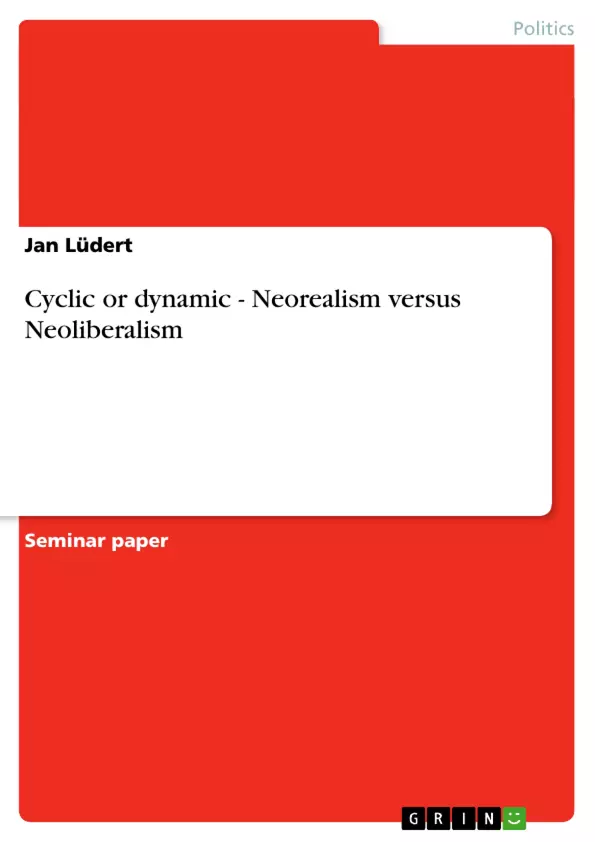Contemporary theory of International Relations is a continuous scholarly battleground for various
schools of thought. This paper will scrutinize two prevailing theories of neorealism and
neoliberalism, namely Kenneth Waltz’s concept of political structures juxtaposed with Robert O.
Keohane’s neoliberal institutionalism. To arrive at a critical conclusion that explains which of the
two constructs stand a better chance of successfully explaining the most fundamental workings of
the international system of states, a four-part sequence is proposed in this paper. Firstly, this paper
will explain how both authors define their assumed principles and how those assumptions are
summarised in relation to the international system. Secondly it will demonstrate where the author’s
ideas intersect and/or divert from the other. Thirdly, it will examine if it is feasible to classify the
ideas as distinct theories or if it is perhaps more accurate to see Keohane’s work as an alteration to
neorealist theory. Finally, by equating the logical consequences of the findings in the preceding
sections, this paper will conclude with a restrictive formulation of the more convincing idea within
the confines of the two texts.
Waltz commences his 1979 chapter on political structures in “Theory of International Politics” by
stressing the need for a system theory of international politics, which is set apart from economic,
social and other international realms. He adapts the idea of structure predominately used by
economists and anthropologists. Waltz is particularly interested in the creation and interaction of
the units within the system and amongst each other, as well as the forces and outcomes that the
units entail. By setting aside “the characteristics of units, their behaviour, and their interactions”
and focusing purely on their position within the structure instead, Waltz argues that an abstract theory of the system will more precisely explain how the structure of political systems affects the
agencies, its units, thereby minimising confusion between system and unit level causalities.
As Waltz continues his deductive approach to political systems he constitutes structure and
interacting units.
Inhaltsverzeichnis (Table of Contents)
- Cyclic or dynamic – Neorealism versus Neoliberalism
- Introduction
- Neorealism
- Waltz's Theory of Political Structures
- Structure and Interacting Units
- The International System as Decentralised and Anarchic
- Neoliberal Institutionalism
- Keohane's Critique of Neorealism
- The Role of Institutions in International Relations
- Types of Institutions
- Comparison of Neorealism and Neoliberal Institutionalism
- Similarities and Differences
- State-Centrism and the Role of Institutions
- The Limits of Neorealism
- Conclusion
Zielsetzung und Themenschwerpunkte (Objectives and Key Themes)
This paper examines the contrasting theories of neorealism and neoliberal institutionalism, specifically Kenneth Waltz's concept of political structures and Robert O. Keohane's neoliberal institutionalism. The paper aims to critically assess the strengths and weaknesses of each theory in explaining the workings of the international system.
- The role of structure and anarchy in international relations
- The influence of institutions on state behaviour
- The nature of state-centrism in both theories
- The limitations of neorealism in understanding contemporary international relations
- The potential for a synthesis of neorealism and neoliberal institutionalism
Zusammenfassung der Kapitel (Chapter Summaries)
- Introduction: The paper introduces the ongoing debate between neorealism and neoliberal institutionalism within the field of international relations.
- Neorealism: This section summarizes Waltz's theory of political structures, emphasizing the importance of system-level analysis and the role of anarchy in shaping state behaviour. It highlights the key concepts of structure, units, and capabilities in Waltz's framework.
- Neoliberal Institutionalism: This section outlines Keohane's critique of neorealism and his development of neoliberal institutionalism. It explores the impact of institutions on state interactions and the importance of cooperation in international affairs. It also examines the different types of institutions, including conventions, regimes, and organizations.
- Comparison of Neorealism and Neoliberal Institutionalism: This section compares and contrasts the core assumptions and arguments of neorealism and neoliberal institutionalism. It explores the divergent views on state-centrism and the role of institutions in international relations. It also examines the limitations of neorealism in accounting for contemporary developments in international relations.
Schlüsselwörter (Keywords)
The key terms and concepts addressed in this paper include neorealism, neoliberal institutionalism, political structures, anarchy, state-centrism, institutions, international system, cooperation, and self-help.
- Quote paper
- Jan Lüdert (Author), 2006, Cyclic or dynamic - Neorealism versus Neoliberalism, Munich, GRIN Verlag, https://www.grin.com/document/90026



